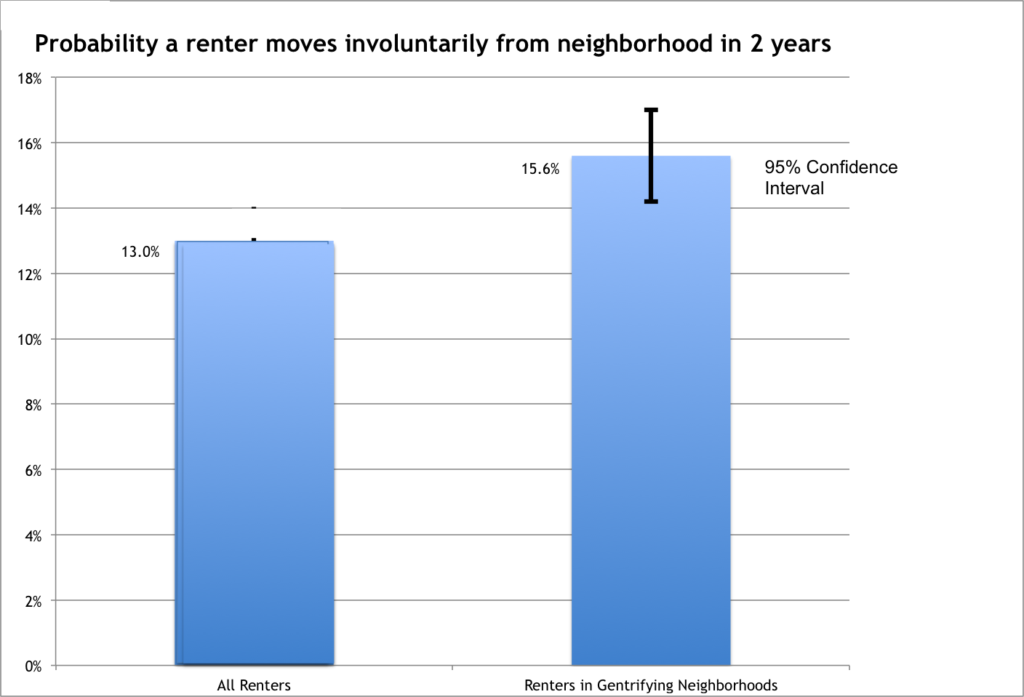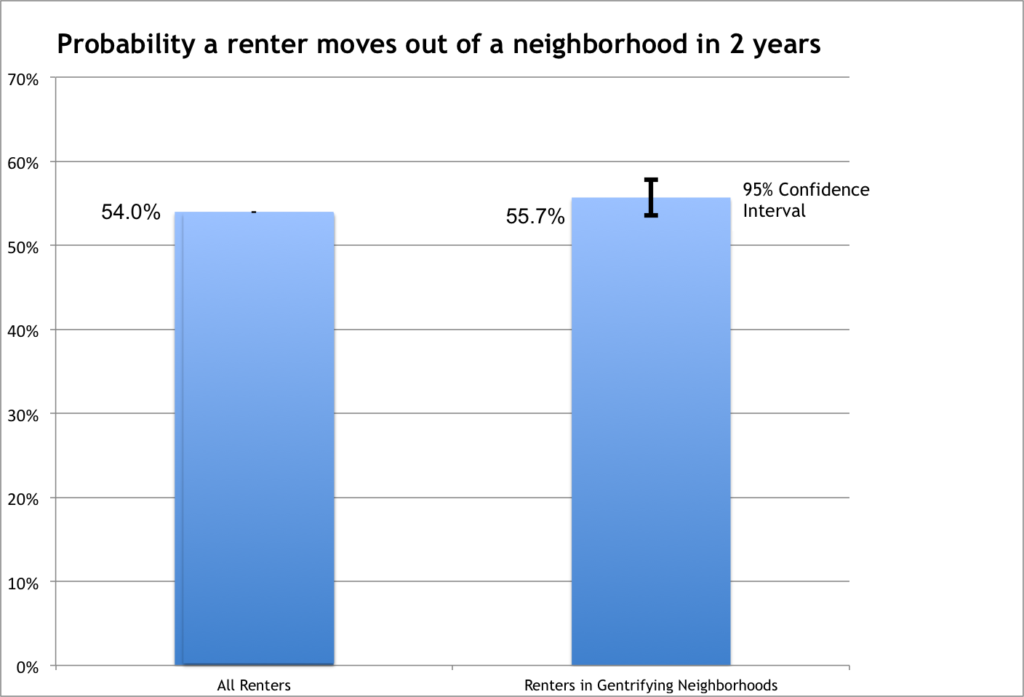Neighborhoods are always changing; half of all renters move every two years.
There’s a subtle perceptual bias that underlies many of the stories about gentrification and neighborhood change. The canonical journalistic account of gentrification focuses on the observable fact that different people now live in a neighborhood than used to live there at some previous time. We seem to assume that most neighborhoods are stable and unchanging, and that absent some dramatic change, like gentrification, the people who lived in that neighborhood are the same ones who lived their a decade ago, and without such change, would be likely to live there a decade hence. But constant population change or turnover is a regular feature of most neighborhoods, a fact confirmed by a recent study. To summarize the key takeaways:
- The population of urban neighborhoods is always changing because moving is so common, especially for renters.
- There’s little evidence that gentrification causes overall rates of moving to increase, either for homeowners or renters.
- Homeowners don’t seem to be affected at all, and there’s no evidence that higher property taxes (or property tax breaks) influence moving decisions.
- While involuntary moves for renters increase slightly in gentrified neighborhoods, there’s no significant change in total moves
In an article published in Urban Affairs Review, “Gentrification, Property Tax Limitation and Displacement,” Isaac William Martin and Kevin Beck present their analysis of longitudinal data from the Panel Survey of Income Dynamics that track family moves over more than a decade. An un-gated version of the paper is available here. One of the challenges of studying gentrification and neighborhood change is that most data simply provides snapshots of a neighborhood’s population at a given point in time, and provides little information about the comings and goings of different households. The PSID sample is unusual, in that in tracks households and individuals over a period of decades–this study uses data on the movement of household heads from 1987 through 2009. Martin and Beck were able to access confidential data that reports neighborhood location and enables them to identify the movement of households to different neighborhoods.
Richard Florida reviewed the Martin and Beck paper at City Lab and highlighted two of the study’s key findings: that homeowners don’t seem to be displaced by gentrification and a subsidiary finding that property taxes (and tax breaks for homeowners) don’t seem to affect displacement. These are both significant findings, but we want to step back and look at the broader picture this study paints of how neighborhoods change, because this study provides a useful context for understanding the complex dynamics of migration that are often left out of discussions of gentrification.
Change is a constant–Most renters have moved on after two years
One of the most striking findings from this study is how frequently renters move. These data show than in any given two-year period a majority (54 percent) of renter households had moved to a different neighborhood. The average tenure (length of time they’ve lived in their current residence) is on average 1.7 years. (Table 1). Moving rates are lower (16 percent over two years) for homeowners, and average tenures are considerably longer (4.9 years, on average). But the important thing to keep in mind is just how much volatility and turnover there is in neighborhood populations. Statistically, if about half of all renters move out of a neighborhood every two years, the probability than any current renter will live in that neighborhood ten years hence is about 3 percent (0.5 raised to the fifth power).
Many of the public discussions of gentrification assume that somehow, in the absence of gentrification, neighborhoods would somehow remain just the same, and that few or no residents would move away. This study shows reminds us that this isn’t true. In addition, we know that for poor neighborhoods that don’t see reductions in poverty rates, that population steadily declines. Lost in Place, our own study of poor neighborhoods shows that over 4 decades, the three-quarters of poor neighborhoods that didn’t rebound lost 40 percent of their population.
Most moves are voluntary
Unlike many other studies, the Martin and Beck paper is able to use survey data to try and discern the motivations for household moves. Broadly speaking they divide moves into “voluntary” and “involuntary” moves. The PSID asks movers why they moved, and those that respond to this open-ended question with answers coded as “moved in response to outside events including being evicted, health reasons, divorce, joining the armed services, or other involuntary reasons” are treated as involuntary moves.As they note, the distinction isn’t always as sharp as one would like, and it may be that some respondents rationalize some involuntary moves as voluntary ones, but the self-reported data are clear: among renters, voluntary moves dramatically outnumber involuntary ones. About 54 percent of all renters moved in the last two years; about 13 percent of all renters reported an involuntary move. That means that about 75 percent of all renter moves were voluntary and about 25 percent of renter moves were involuntary. As Margery Turner and her colleagues at the Urban Institute have shown, moving to another neighborhood is often the way poor families get better access to jobs, better quality schools, safer neighborhoods and better housing.
Gentrification has no impact on overall renter moves, but is associated with a small increase in involuntary moves
One of the most important studies of gentrification is Lance Freeman’s 2005 paper “Displacement or Succession?: Residential Mobility in Gentrifying Neighborhoods” which found that gentrification had essentially no effect on the rate at which households moved out of gentrifying neighborhoods. Martin and Beck replicate this finding for all moves by renter households, they write:
Consistent with Freeman’s findings, Model 2 indicates that we cannot be confident that the average effect of gentrification on the probability of moving out is different from zero.
Graphically, Martin and Beck’s findings are can be depicted as follows. About 54 percent of all renters move within two years. According to Martin and Beck’s modeling, the probability that a person in a gentrifying neighborhood moves in two years is about 1.7 percentage points greater than for the typical person (after controlling for individual household characteristics). That suggests that for a typical resident, their probability of moving in a gentrifying neighborhood is about 55.7 percent, but that estimate in not statistically significant.
When they look just at “involuntary” moves, however, they find that there is a statistically significant effect of gentrification on the probability of moving. Specifically, they find that rental households in in gentrifying neighborhoods are about 2.6 percent points more likely to report an in “involuntary move” in the past two years than those who don’t live in gentrifying neighborhoods. Its important to put that in context. According to the paper, about 54% of all renters moved in the last two years, and about 13 percent of them experienced an “involuntary move.” The estimate in the paper is that the effect of living in a gentrifying neighborhood is about a 2.6 percentage point increase in the likelihood of an “involuntary” move. That means if the average renter has a 13 percent chance of an involuntary move, a renter in a gentrifying neighborhood has a 15.6 percent chance of such a move. These results are shown below:

Here, the estimate that a renter makes an involuntary move from a gentrifying neighborhood (+2.6 percentage points) is greater than the 95 percent confidence interval, which suggest that there is a statistically significant difference between the share of the population experiencing involuntary moves in gentrifying neighborhoods as compared to all neighborhoods.
What would that look like in a typical neighborhood? If you have a neighborhood with 2,000 households (about 5,000 people, with about 2.5 persons per household), and about half are renters and half are homeowners, you would expect of the 1,000 renting households that about 130 households would experience an involuntary move over a two year period. If that tract gentrified, you would expect an additional 26 households to experience an “involuntary move.” But you would also expect 530 total households to have moved out of the neighborhood in that time, for all reasons, voluntary and involuntary. These data put the scale of the gentrification effect in perspective. Whether or not they gentrify, there’s going to be enormous change in the renter population of any given urban neighborhood.
Gentrification has no impact on homeowner moves
Martin and Beck find no evidence that homeowners in gentrifying neighobrhoods are more likely to move, either in the aggregate, or involuntarily. They test a number of different models of the connection between gentrification and moving: none produce statistically significant correlations between gentrification and moving; in some cases (though statistically insignificant) the correlation is negative: gentrification is associated with fewer homeowners moving from a neighborhood. Their conclusion: for homeowners, their study “produces no evidence of displacement from gentrifying neighborhoods.”
Property taxes (and tax breaks) seem to have no connection with homeowner movement from gentrifying neighborhoods
One popular argument is that gentrification pushes up property values and results in higher property taxes for homeowners, and that especially for households with a fixed income, the burden of higher property taxes is likely to force them to move. Martin and Beck look closely at this question, and examine how changes in property assessments and property taxes correlate with the probability of moving. They find that there’s no statistically significant link between property taxes and moving in gentrifying neighborhoods. Several states and localities have enacted property tax or assessment limitations, in part with the objective of lessening the financial exposure of fixed income households to the burden of higher property taxes. Martin and Beck look at the relationship between such limits and the probability of moving, and find that such limits don’t seem to have any effect on whether homeowners move out of gentrifying neighborhoods or not.
While homeowners in gentrifying neighborhoods have to shoulder the burden of paying higher property taxes, its typically only because their homes have appreciated more in value. In most cities, property taxes are levied at a rate equal to about 1 to 2 percent of a property’s market value, so the wealth effect of property appreciation dwarfs the negative income effect of having to pay higher property taxes.
Urban renters are a highly mobile group. Most renting households are likely to have changed neighborhoods in the past two years. We observe the same overall level of movement out of neighborhoods whether they gentrify or not. This study suggests that somewhat more of those moves would be involuntary rather than voluntary.


